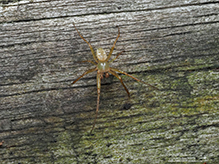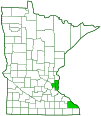green-legged orbweaver
(Mangora maculata)
Conservation • Description • Habitat • Biology • Distribution • Taxonomy
|
|
||||||||||||||
Description |
Green-legged orbweaver is a small typical orb weaving spider. It occurs in the United States east of the Great Plains, and in southern Quebec and Ontario Canada. It is one of the two most common Mangora species in the eastern U.S., the other being tuftlegged orbweaver. Adults are active from early June to October. They are found in the herb and shrub layer of deciduous forests, especially in river flood plains. They are also found on ferns and sedges at the edges of swamps and bogs. They are sometimes also found in fields. The female is ⅛″ to 3⁄16″ (3.6 to 5.5 mm) in length with a 3⁄16″ to ⅜″ (5 to 10 mm) legspan. The male is smaller, ⅛″ (2.7 to 4.0 mm) in length. The front part of the body (cephalothorax) and the legs are yellowish white or greenish yellow. The upper side (carapace) is much smaller than the abdomen. It is longer than wide and pear-shaped when viewed from above, more or less circular at the rear and strongly narrowed in front. It is moderately convex when viewed from the side. There is a longitudinal furrow in the middle. A short, narrow, faint stripe extends from just behind the eyes into the furrow. There is a similar dark stripe on the lateral margins. There are eight eyes arranged in two parallel rows of four eyes each. The rear row is curved forward and the front row is straight or slightly curved backward. All of the eyes are small, but the median eyes are larger than the lateral eyes, and the posterior median eyes (PME) are slightly smaller than the anterior median eyes (AME). On each side the lateral eyes are widely separated from the middle (median) eyes and are almost touching each other. The PME have black eye rings. The median ocular area (MOA), the area defined by the middle four eyes, is longer than wide and narrower in front than behind. The abdomen may be large and elliptical or oval and narrowest in front. The upper surface is white or whitish with a mesh-like network of medium to light brown lines. There are three pairs of small black spots near the rear. The area between the spots is darker. The legs are pale, and they are armed with long, black, spine-like hairs. The third segment (femur) has a greenish tint that may be dark, light, or very pale. This is the feature that gives the species its common name. On the fifth segment (tibia) of the third pair of legs there are two oblique rows of 5 or 6 long. feathery hairs on the underside near the base. |
Size |
Female Body Length: ⅛″ to 3⁄16″ (3.6 to 5.5 mm) Male Body Length: ⅛″ (2.7 to 4.0mm) Legspan: 3⁄16″ to ⅜″ (5 to 10 mm) |
Web |
A tightly woven hunting web is constructed in grass or on a low bush. It is called an “orb”, which gives this family of spiders its common name. The orb may be horizontal or slightly inclined. It is 6″ to 12″ (15 to 30 cm) in diameter, very large for such a small spider. It has 50 to 60 radii and 50 or more, usually closely spaced, sticky (viscid) spirals. The center (hub) has 10 to 12 non-sticky turns and is separated from the viscous threads by a free zone. |
Similar Species |
Habitat |
Deciduous forests, the edges of swamps and bogs, and sometimes fields. |
Biology |
Season |
Early June to October |
Behavior |
|
Life Cycle |
|
Food |
|
Distribution |
||
|
Sources |
|
| 8/16/2025 | ||
Occurrence |
||
|
||
Taxonomy |
|
Class |
|
Order |
|
Suborder |
Araneomorphae (Typical Spiders) |
Infraorder |
Entelegynae |
Superfamily |
Araneoidea (orbweavers and allies) |
Family |
|
Subfamily |
Araneinae (typical orbweavers) |
Genus |
Mangora |
Subordinate Taxa |
|
|
|
Synonyms |
|
Abbotia maculata Eperia maculata Mangora ornata |
|
Common Names |
|
greenlegged orbweaver green-legged orbweaver |
|
Glossary
Carapace
The hard, upper (dorsal), shell-like covering (exoskeleton) of the body or at least the thorax of many arthropods and of turtles and tortoises. On crustaceans, it covers the cephalothorax. On spiders, the top of the cephalothorax made from a series of fused sclerites.
Cephalothorax
The front part of the body of various arthropods, composed of the head region and the thoracic area fused together. Eyes, legs, and antennae are attached to this part.
Femur
On insects and arachnids, the third, largest, most robust segment of the leg, coming immediately before the tibia. On humans, the thigh bone.
Tibia
The fourth segment of an insect leg, after the femur and before the tarsus (foot). The fifth segment of a spider leg or palp. Plural: tibiae.
Visitor Photos |
||
Share your photo of this arachnid. |
||
This button not working for you? |
||
Alfredo Colon |
 |
MinnesotaSeasons.com Photos |
||
|
||
|
||

Visitor Videos |
||
Share your video of this arachnid. |
||
This button not working for you? |
||
|
Other Videos |
||
|

|
Created: 8/17/2025 Last Updated: © MinnesotaSeasons.com. All rights reserved. |




